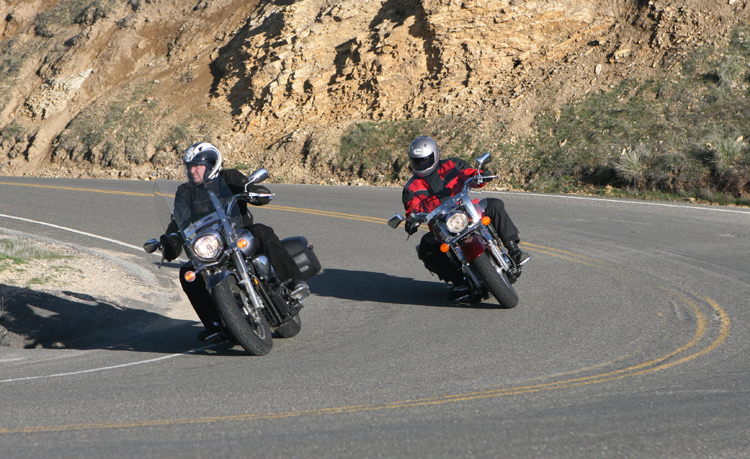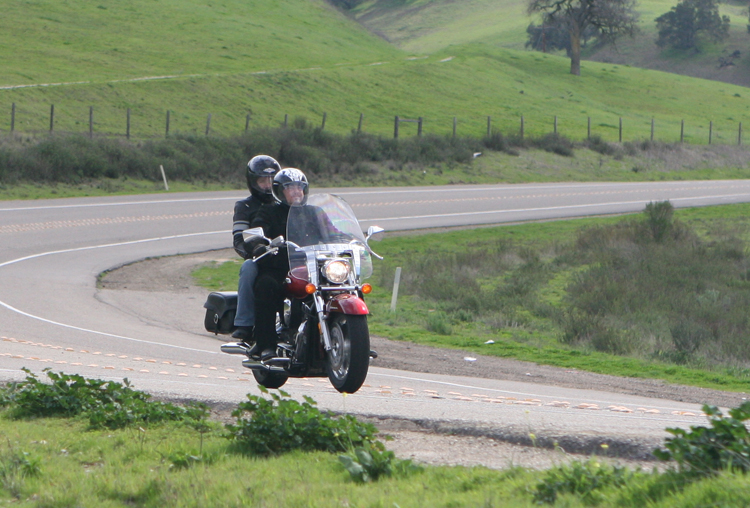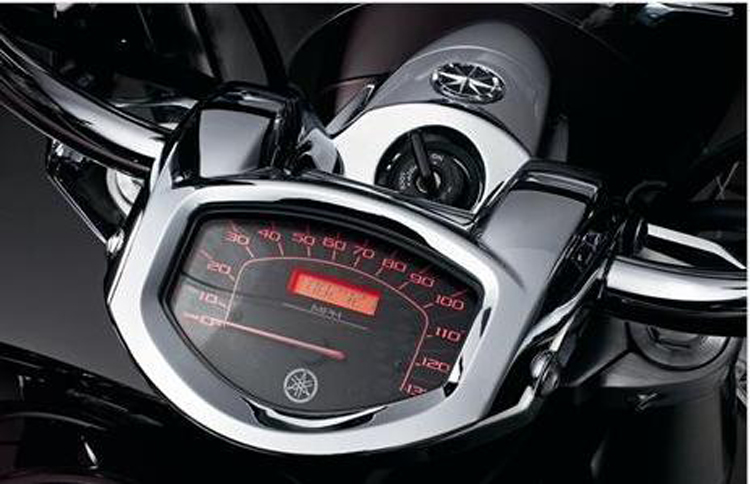2008 Honda VTX 1300T vs. 2008 Yahama V-Star 1300 Tourer

At first blush, we expected these machines to ride and feel nearly the same, but after hundreds of test miles, their separate identities began to emerge more clearly. A multi-day trip up the California coast to scenic Morro Bay, with a diversion inland on snow-lined mountain roads, steep, twisty canyons, woodlands, broad plains and even hours of steady highway riding, gave us a chance to experience both machines in a variety of riding conditions.
Rarely do we test motorcycles side-by-side that are so close in design, style, displacement, price and mission than these two: the Honda VTX 1300T and Yamaha V-Star 1300 Touring. Both machines offer classic cruiser styling with hefty 80-cubic-inch engines, full windscreens, saddlebags and passenger backrests - and either can be purchased for just north of 11 grand. In fact, their specifications are so similar that many potential buyers would find it confounding to decide which to choose without the opportunity of a test ride - something many dealers don't allow.
Engine & Transmission
Most cruiser buyers prefer traditional V-twin engines, a lumpy rumble and plenty of torque at low rpm - and that's what we have here. Although finned cylinders give both engines an air-cooled appearance, Honda and Yamaha chose liquid cooling for these engines. This allows more power to be extracted, along with increased longevity, less noise and lower exhaust emissions. To retain a traditional cruiser visage, the radiators are fairly well hidden. Each also has a thermostatically controlled electric cooling fan on the radiator to help keep temperatures in check at low speeds and when idling. Both engines utilize screw and locknut valve adjustments, which reduces labor costs compared to shim-type adjusters.

Honda's engineers chose a single-pin crankshaft, a 52-degree angle between cylinders and an "undersquare" bore/stroke of 89.5mm x 104.3mm respectively to produce 1,312cc. Compression is 9.2:1. The SOHC engine breathes through three valves per cylinder - two intakes and one exhaust - an interesting compromise that flows better than two valves and costs less than four valves. Honda also developed a dry sump lubrication system which holds engine oil within the gearbox case instead of requiring an external tank.
The VTX's engine is rubber mounted, and dual two-axis primary counter balancers are designed to further reduce vibration. An ECU uses digital 3-D ignition timing maps for each cylinder, and twin spark plugs per cylinder ensure more complete combustion. The VTX has a smallish single 38mm-bore constant-velocity carburetor featuring a manual choke located beneath the left side of the gas tank. The carb is warmed by engine coolant to aid fuel vaporization and reduce stumbling during warmup, so within a few blocks you can take off the choke.
Yamaha's designers also chose a single-pin crankshaft, but set the cylinders apart at a wide 60 degrees and used an "oversquare" 100mm x 83mm bore and stroke that yields 1,304cc. Compression is 9.5:1. A single-overhead camshaft is also used but, unlike the Honda, it opens four valves per cylinder.

The V-Star's Mitsubishi electronic fuel-injection controls a duo of 40mm throttle bodies, and there's no manual cold-start control. An oxygen sensor and three-way catalyst (located in the front of the muffler) keep emissions low. The engine starts instantly every time and responds well, even when cold.
The V-Star engine has single-axis, double crankshaft balancers to reduce vibration, but it is solid mounted to the frame. Surprisingly, the rubber-mounted Honda's vibrations are considerably more noticeable than the Yamaha's, especially at idle and while accelerating.

Honda does not publish horsepower or torque specs, whereas Yamaha claims 76.8 horsepower at 5,500 rpm and 81.8 lb-ft of torque at 4,000 revs. Out on the road, the V-Star four-valve, fuel-injected engine is noticeably more powerful than the Honda, with a stronger top-end pull. The VTX's performance is limited by its small carburetor and three-valve heads, and seems to have noticeably less power and runs out of steam at lower revs than the V-Star. As for bottom-end torque, the Honda seems to have slightly more at low rpm, but it feels like it tapers off sooner than the Yamaha's.
Both bikes have cable-actuated multi-disc wet clutches. Lever pull is moderate, and engagement is smooth and chatter-free. Each also has a five-speed transmission with heel-and-toe shifter. Both worked well, with no missed gears, and neutral is quite easy to find, even when stopped.
We found the overall gearing on the Yamaha to be better for relaxed cruising at highway speeds. On the Honda, we were constantly reaching for a higher gear at speeds above 60 mph, although it was already in fifth. Sometimes, though, when shifting the V-Star from neutral to first gear, it didn't go in on the first tap of the lever.

Honda chose shaft drive, while Yamaha went with a toothed-belt and sprocket setup. Both systems are quiet, clean and nearly lash-free. Belts usually last for a long time, but eventually need replacement at a moderate cost. Typically, a shaft drive lasts the life of the bike, with perhaps an occasional lube change, but if it does fail it can be quite expensive to replace or overhaul.
Chassis & Brakes
The two brands have conventional 41mm non-adjustable hydraulic forks, double-downtube backbone type tubular-steel frames with double-sided swingarms. In back, Honda mounts dual rear shocks, while Yamaha installs a single shock; both are adjustable for preload only.
The VTX has 5.1 inches of fork stroke and 3.7 inches of rear travel, while the V-Star has slightly more at both ends, with 5.5 inches and 4.5 inches. Cruisers typically scrimp on suspension components, with no damping or fork preload adjustments, and this is the case here. Ride quality is on the plush side, but wallows more than we'd prefer, with the Yamaha feeling a tad better.
Each bike came from the factory with Dunlop rubber: a D404F in front and a K555 at the rear. Honda uses a 140/80-17 front and 170/80-15 rear, while Yamaha spoons a 130/90-16 on the front and a 170/70-16 at the back. The tires offer reasonable grip and don't chase pavement grooves and seams; but, of course, bias-ply tires have a less precise feel than radials.

When leaned over hard in a fast corner, small irregularities in the pavement get the Honda's front end to shudder in what feels like fork and chassis flex, and it's quite disconcerting. The V-Star's solid-mounted engine helps increase chassis rigidity and it feels more solid when ridden hard. Also, the VTX's low running boards scrape in turns well before the V-Star's touch down.
Honda installs a single 336mm rotor in front with a Nissin two-piston pin-slide caliper. In the back, a single-bore caliper clamps a 296mm solid rotor. Yamaha provides dual 298mm front rotors gripped by two-piston pin-slide calipers. Out back, the Yammie also gets a single 298mm rotor with a one-pot clamper.
When it comes time to slap on the binders, the brakes on either model work well enough to please most owners. However, we found the Honda's single front brake needed more lever effort to halt the VTX than the Yamaha's double-front setup. On the Yamaha, though, it was difficult to avoid rear-wheel skidding during panic-braking stops.

We rode both bikes hard and fast on hilly and mountainous terrain, and about half the time each bike carried a passenger. Still, our average mileage was lower than expected, especially with the Honda. The VTX averaged only 34.4 mpg, with its 4.8-gallon tank yielding a range of 165 miles. The V-Star averaged 38.6 mpg, which, with its 4.9-gallon tank, works out to a range of 189 miles. Regular 87-octane gas is approved for both engines.
Honda claims a curb weight of 748 pounds for the VTX 1300T, while the V-Star's claimed wet weight is 712 pounds. Both bikes could benefit from a weight-loss program, which would quicken their handling, improve performance and fuel economy, and make them easier to maneuver.

Accessories & Arrangements
Out on the road the Honda's windscreen is more rider-friendly than the Yamaha's. Its height allows most riders to just peer over the top edge, while it directs the wind blast up and around without much turbulence. Over the years we've found that height to work the best, especially when riding into a low sun, or at night when oncoming headlight glare makes the plastic seem opaque.

The V-Star's screen is one of the tallest we've seen, and there's no way you can look over it unless you're standing up. It's also almost vertical, rather than raked back, and the combination seems to cause a strong rush of air to come up under the windscreen to fill the low-pressure void behind the screen. This blast hits the rider's torso and chin and the wind goes right up behind the helmet face-shield, causing extra noise, and watery eyes in cool weather.
Wide pullback handlebars are fitted to both bikes, and we found the V-Star's bar to be more comfortable, but some riders may prefer the VTX's. Mirrors are steady and wide enough apart, but the VTX's angle downward and don't have enough adjustability to bring them level unless you move the handlebar up in an unnatural position.

Honda mounts the instrument cluster on the gas tank in traditional cruiser fashion and Yamaha situates it above the top triple clamp. Both clusters consist of an analog speedometer with odometer and dual tripmeters, along with the usual indicator lamps. In addition, the Yamaha has a digital clock and low-fuel indicator lamp, but neither bike has a tachometer or fuel gauge. Either cluster is fairly easy to read day or night, although the Yamaha's is closer to the rider's line of sight; so you don't have to look away from the road as long to view it.
The Honda's front saddle height is 27.4 inches, while the Yamaha's is a tad higher at 28.1 inches. Taller riders are likely to prefer the V-Star's riding position, while shorter ones will find the Honda more suitable. Over six-feet tall, I found the VTX felt a bit cramped, which was exacerbated by the forward-sloping rear lip of the seat. Fortunately, buyers can sit on the bikes prior to purchase to determine how they feel.
Pillion accommodations are fairly plush on both bikes, with a reasonably sized saddle, good footpeg positions and a padded backrest, which adds comfort and security. Our SAE-approved passenger preferred the Honda's seating to the Yamaha's by a small margin.
Luggage is important on a touring bike, and the smallish VTX's soft saddlebags are non-lockable and only have enough room to stuff a typical gym bag into either side. They have a metal framework that limits the size of the opening, and a single adjustable belt-buckle-type strap with a plastic quick-connect buckle underneath holds the lid closed. The bags are rubber mounted only at the forward end, so the rear portions swings freely. Yamaha, on the other hand, provides large, hard-shell saddlebags that can hold substantially more than the Honda's - and they are lockable too.
Test Summary
The Honda VTX 1300T and Yamaha V-Star 1300 Tourer are solid, topnotch machines in the mid-displacement cruiser category. Each provides good value, and either one should give long, dependable service that will meet or exceed the expectations of their owners.
Both brands sell a slew of goodies to allow owners to accessorize their bikes. Yamaha mainly offers chromed and billet appearance items, along with some small luggage racks. Among Honda's offerings are heated handgrips, and an audio system that plugs into and plays music stored on MP3 or iPod devices, with a weatherproof speaker strip-mounted crosswise above the handlebar, aft of the windscreen, so the rider can hear it well.
The VTX 1300T has a manufacturer's suggested retail price (MSRP) of $ 10,999 for black and $ 11,099 for silver or red (as tested). The Yamaha's MSRP is $ 11,190 for Black, Cherry or Seashell, and $ 11,390 for Silver (as tested).
Based on our experience with these machines, the Yamaha edged out the Honda in a number of areas, moving it to the top of our rankings in this comparison. The considerations placing it there include a more powerful, fuel-injected four-valve engine, dual front brakes, and better handling, ergonomics, instrumentation, and highway performance.
Second Opinion - Eric Bass
I definitely concur with my friend, Freund, that the V-Star offers better value than the VTX by a slim margin. But the cruiser rider who only scrapes floorboards when swerving to avoid fuzzy bunnies, obeys all speed limits, and doesn't live in Montana really won't notice much difference between the two. However, at speeds above 75 mph the Honda begins to wind up as if it's running out of revs, and grows annoyingly urgent at 80mph or above. This is just one example of how the V-Star pulls ahead of the VTX in small but significant ways. Considering the bikes' nearly identical MSRP, thoughtful details lacking in the Honda - such as taller gearing, locking bags, fuel injection, steering lock in the ignition, a reserve-fuel light, better mirror and lever design - all add up to tip the scales in favor of the Yammer.
It isn't hard to see why someone might logically prefer the VTX though. I'm shorter than Ken and found that the reach to the bars, seating position, and sub-eye-level windscreen suited me better on the VTX. Aesthetically, the Honda's styling is more traditional, the pipes offer a meatier tone, and the engine a more visceral pulse. So while my vote also goes to the V-Star, I would still recommend that a potential buyer consider the VTX on its own merits. They might reasonably draw a different conclusion.
Technical Specs
2008 Honda VTX 1300T
+ Engine sounds better, has more cruiser character, far better windscreen, ergonomics better for smaller riders
- Carburetion w/choke, fuel reserve
Distributor American Honda Motor Co. Inc.
MSRP $ 11,099
Engine 52-degree V-twin, SOHC
Displacement 1,312cc
Bore x Stroke 89.5 x 104.3mm
Fuel System single 38mm CV carburetor
Power n/a
Cooling liquid
Ignition 3-D digital-inductive type
Transmission 5-speed
Frame tubular steel double downtube backbone
Front Suspension 41mm conventional fork, non-adjustable
Rear Suspension twin shocks,adjustable preload
Rake/Trail 32°/144mm
Front Brake single 336mm disc, 2-piston caliper
Rear Brake single 296mm disc, 1-piston caliper
Front Tire 140/80-17
Rear Tire 170/80-15
Curb Weight 748 lbs. (339 kg)
Wheelbase 65.7 in. (1668mm)
Seat Height 27.4 in. (696mm)
Fuel Capacity 4.8 gal. (18.1 L)
Fuel Consumption 34.4 mpg
Colors Black, Red, Silver
Yamaha V-Star 1300 Tourer
+ Smoother, more powerful engine, roomier for larger riders, bigger, lockable luggage
- Overly tall windscreen
Distributor: Yamaha Motor Corp. USA
MSRP $ 11,390
Engine 60-degree V-twin, SOHC
Displacement 1,304cc
Bore x Stroke 100.0 x 83.0mm
Fuel System multipoint sequential electronic fuel injection
Power 76.8hp
Cooling liquid
Ignition digital-inductive type
Transmission 5-speed
Frame tubular steel double downtube backbone
Front Suspension 41mm conventional fork, non-adjustable
Rear Suspension single shock,adjustable preload
Rake/Trail 32.7°/145mm
Front Brake twin 298mm discs,2-piston calipers
Rear Brake single 298mm disc,1-piston caliper
Front Tire 130/90-16
Rear Tire 170/70-16
Curb Weight 712 lbs. (323kg)
Wheelbase 66.4 in. (1686mm)
Seat Height 28.1 in. (713mm)
Fuel Capacity 4.9 gal. (18.5 L)
Fuel Consumption 38 mpg
Colors Black Cherry, Seashell, Silver






















